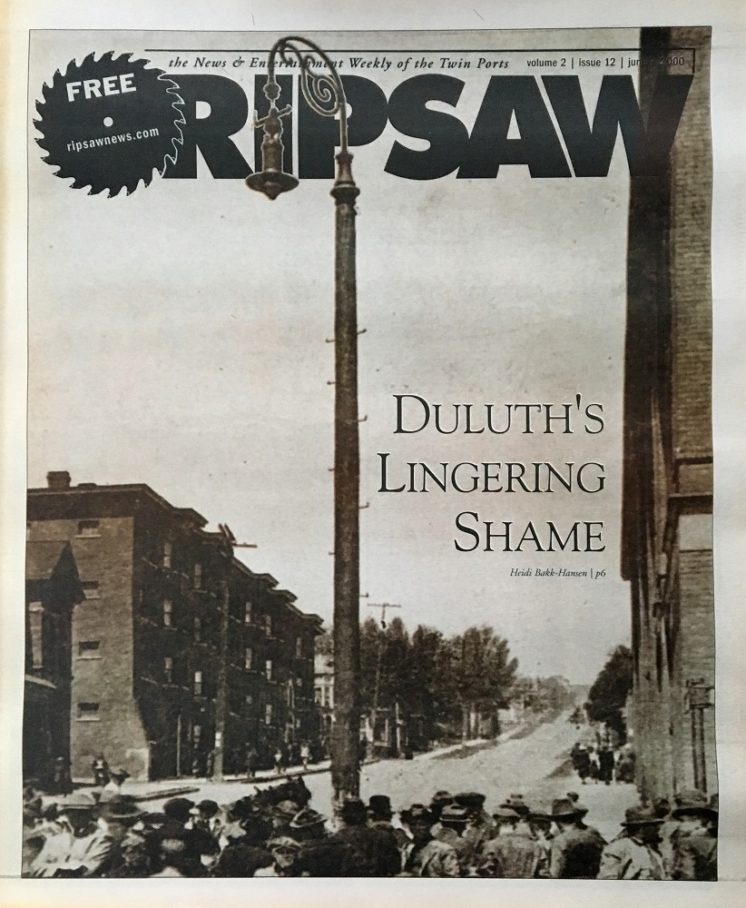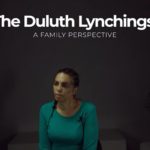Duluth’s Lingering Shame: Clayton, Jackson, McGhie Lynching
Below is the complete text of a story from the June 7, 2000 issue of Duluth’s Ripsaw newspaper.
Duluth’s Lingering Shame
Eighty years ago Duluthians carried out one of the most horrific acts this region has ever seen. How did it happen? Have we changed?
By Heidi Bakk-Hansen
 They’re selling postcards of the hanging
They’re selling postcards of the hanging
They’re painting the passports brown
The beauty parlor is filled with sailors
The circus is in town
Here comes the blind commissioner
They’ve got him in a trance
One hand is tied to the tight-rope walker
The other is in his pants
And the riot squad they’re restless
They need somewhere to go
As Lady and I look out tonight
— From Bob Dylan’s “Desolation Row”
On June 15, 1920, a mob of 10,000 lynched Isaac McGhie, Elias Clayton and Elmer Jackson at the corner of First Street and Second Avenue East in Duluth.
There is no other event in our local history that carries such profound emotional turmoil. For most, it inspires a collective shame that is easiest met with the balm of forgetfulness. For those whose roots are deep in Duluth’s neighborhoods, there is a deep split along cultural lines. On one side are those who hold the fervent — if futile — hope that their not-so-distant ancestors stayed home that night. On the other is the conviction that a symbol of continued outsider status lurks within the images of the tragedy. Newcomers find it a bewildering event, mismatched in its ugliness with a place they have sought for its beauty. For all but a few, it has been a distant past blurred by a wall of silence.
The Times
Post-war Duluth was rife with labor tension. The veterans of the Great War were bored, often unemployed, and seeking the diversion of noble causes. Severe class and nationality segregation divided the city. The people of Duluth felt secure in their belief that the violence of lynch law, especially against black men and women, was something Southern in nature — something that could not happen here.
Out of approximately 100,000 Duluthians, only about 500 or so were African-American, most of whom were forced by housing discrimination to live in the far west area known as Gary. In all likelihood, there were still residents of the city who had never even laid eyes on a black person. But this was Minnesota — a Northern state proud of its citizens’ role in the Civil War. The North was supposed to be different in the way it accepted black people. Lynchings, however, were a topic of conversation. A treatise against the horror of lynching was one of the more popular oratories memorized and recited at Denfeld High School. Nevertheless, in October of 1918, a Finnish antiwar “agitator” had been tarred, feathered and lynched in Lester Park.
The early 1900s was a time deeply steeped in the fear of the Other. In April of 1920, The Rising Tide of Color Against White World Supremacy, by Lothrop Stoddard, hit mainstream bookshelves. According to Richard Hudelson, a philosophy professor at the University of Wisconsin-Superior, Stoddard’s beliefs were considered anything but “out there.” Prominent scholars and scientists alike advocated something now called “scientific racism,” which used pseudo-scientific “facts” to prove the inherent biological and anthropological inferiority of races not European in origin. Many believed that white men were the most powerful cultural group because of their inherent superiority to all others — women and people of color included. But not only were white men considered superior, the “lower orders” were commonly believed to be dragging down the “white world” — only by fighting for what was “theirs” could this be prevented. The resurgence of the Ku Klux Klan was only one symptom of a culture bent on separation of the races.
Women were getting more involved in the political arena, but the idea of “hysteria” as a specifically female disability was widely believed as fact. First-wave feminism flailed away at restrictive feminine roles and definitions, but the struggle met with open hostility by large numbers of both men and women. Feminine purity remained an expectation rather than a simple fantasy. Being raped was a horror that would ruin a woman forever, but being raped by a black man carried cultural taboos so serious, it was, viewed through the internal codes of the time, worse than being murdered. The idea that a white woman would lie about such a crime was virtually inconceivable.
Racial tensions ran high all over the country. Race riots erupted in cities across the nation, many people were murdered and black neighborhoods, already plagued by enforced poverty, were burned to the ground by marauding groups of vengeful white men.
And Then, In Duluth
Some time on the evening of June 14, 1920, Irene Tusken and James Sullivan, both young West Duluthians, went to the circus that was visiting town. Something happened — no one can be sure what — that led them to claim they had been threatened with a pistol, robbed and Tusken raped by six black circus workers. This accusation, first levied by Sullivan and backed by no physical evidence or witnesses beyond Sullivan and Tusken, quickly snowballed. In the wee hours of June 15, police removed at least 50 black men from the circus train before it began its journey north to Virginia, Minn. Extraordinarily vague descriptions of the alleged assailants led to several arrests, while word of the supposed crime spread.
By evening, a crowd of many thousands, bent on what it considered justice, had gathered in front of the city jail, then located on Second Avenue East and Superior Street. Spurred on by cries of “What if it was your daughter? What if it was your sister?” the crowd battered at the jail for hours. They were opposed only by a pitifully small force of police that became even more crippled by an order from the commissioner of public safety to refrain from using guns to defend the jailed suspects. Subsequently, the crowd managed to extricate three of the imprisoned men from the jail, subjected them to a “kangaroo court,” dragged them up the hill, beat them severely and lynched them on the light pole at the corner of First Street and Second Avenue East.
Few members of the lynch mob received any punishment. Two who did stand trial, Henry Stephenson and Louis Dondino, served less than half of their five-year sentences for rioting. Another circus worker, Max Mason, was convicted of raping Tusken based on evidence later believed to be false and politically motivated. Mason was released quietly after serving four years of his 30-year sentence.
The Questions
There are a thousand whys, only some of which can be answered through the filter of years and the clarity of distance. Why were Sullivan and Tusken so readily believed on such flimsy evidence? Why was such an incredibly large crowd (one in ten of Duluth residents) eager to join in such a horrifying melee? Why did the commissioner not call on the National Guard, which was gathering just a few blocks away for weekend duty? Why did he order the 11 police officers in the jail to put their guns away? Why were the perpetrators left almost wholly unpunished? Why did it happen here?
But there is one question that burns hotter than most — a question that can never be answered. Was Tusken truly the victim of a crime? Marshall Johnson, a sociology professor at UWS reports one of his students contacted a relative of Tusken’s some time after Tusken’s death. Reportedly, the relative confirmed that Tusken was not raped. Still, no one was able to settle the question before Tusken’s death. If her accusation was false, it is likely that Tusken felt strong pressure to keep quiet.
The questions overwhelm. It is not hard to see why the almost immediate response of many Duluthians was to try to forget. The Duluth News-Tribune on June 17, 1920, printed an editorial entitled “Duluth’s Disgrace.” The editorial stated, “Duluth has suffered a disgrace, a horrible blot upon its name that it can never outlive.”
On June 21, a man identified only as “Jack” wrote in a letter to the editor, “Last week’s happening is indeed unfortunate — it cannot be undone, therefore it is better the quicker it is forgotten.”
The Aftermath
Indeed, during the years since the lynching, the effort to forget has been strong. A St. Louis County Historical Society employee in the 1940s reportedly threw out the file on the incident, deeming it too unseemly for study by Normal School students. All but a silent few forgot the location of the victims’ unmarked graves. Minnesota History courses required for teachers in training did not mention the incident. Postcards made to celebrate the incident quickly sold out immediately afterward but were eventually hidden away in attics. Many of the men and women present that night did not speak of it again. One of the police officers who defended the jail, when questioned about it in the 1970s, claimed to have no memory of a night that must have been the most significant experience of his career.
At the Duluth Public Library there is only one well-worn box in the Duluth News-Tribune microfilm archives — the rest look nearly untouched. The box, repaired with yellowing tape, contains the newspapers from June 15, 1920, and the weeks afterward. For years, people who wanted to know anything about the horror of that night found this box the only commonly available source of information.
However, in the minds and histories of some Duluthians, the story did not disappear. The day after the lynching, “idle Negroes” were banished from Superior, forced to walk across the bridge to Duluth, prompting panicked calls to police by fearful whites. For months, some black residents received terrorizing phone threats. People banded together for safety, putting the children to sleep upstairs while the adults stayed awake in darkened front parlors watching for trouble. Housing became even more difficult to attain, and many jobs were suddenly unavailable to people of color. In the few years after the lynching, half of Duluth’s African-American population moved away. Those who stayed kept the memory of the victims alive by honoring the Crawford Mortuary with the business of mourning their dead. Crawford was the funeral home that accepted the bodies of the lynching victims after another funeral home refused.
Outside Duluth, at least two black men who later became involved in national politics were deeply affected by the lynching. Roy Wilkins, long-time president of the NAACP, devotes three pages of his autobiography to his reaction to the incident. Reportedly, the event spurred him to become a civil rights activist. Elisha Scott, the first lawyer to sign on to the Brown v. Board of Education of Topeka case, was the lawyer hired by Elmer Jackson’s father when he came north seeking reparations for his son’s murder.
The Awakening
Finally, someone stepped forward to break the silence. In the 1970s, Michael Fedo, a Duluth native, prepared to write a novel set in post-WWI America. He planned to include a lynching and remembered hearing, when he was about 10 years old, about a lynching that had occurred in Duluth. He assumed a book had already been written about it.
“When I learned it wasn’t out there, I decided to write it myself,” he said.
And write it he did, putting together an analysis of the times, the mob and the details in such a way to make them readable and easily understood. His efforts, however, were not terribly well received. The publishing arm of the Minnesota Historical Society showed no interest. Twice, small presses published his book under the titles They Was Just Niggers — a declaration made by one of the perpetrators — and Trial by Mob. But then, in 1999, the Minnesota Historical Society changed its position. Now the book is, for the first time, widely available under the title, The Lynchings in Duluth. Within its pages Duluthians can learn the truth about the most horrifying event in their grandparents’ and great-grand-parents’ lives, perpetrated on the soil of their own hometown.
In the early 1990s others became publicly interested in addressing some of the story’s missing pieces. First Henry Banks, then in charge of planning the Martin Luther King Day celebrations in Duluth and now the owner of the Diversity Store, sought some recognition of the site of the lynching itself. He feels that part of the reason the lynching has not been lived down is because it is being hidden away.
“Young people needed to know so that [history] didn’t repeat itself,” he said.
The NAACP-Duluth subsequently joined in an effort to raise awareness and place a wreath at the site. This effort spurred further action and research by Bob Baldwin, former president of the local NAACP, in order to permanently mark the site with a memorial. Unfortunately, this effort faded.
Soon after, a dispute over the placement of the new county jail led to the discovery of the gravesites. In an effort led by Craig Grau, a political science professor at the University of Minnesota-Duluth, it was discovered that unmarked graves in Park Hill Cemetery provided a final resting place for McGhie, Jackson and Clayton. Grau and others established a fund, held a ceremony to place gravestones and used the money left over to set up a small scholarship fund at UMD in the victims’ names. Because of his part in this effort, Grau was later invited to witness the ceremonial naming of an overpass in Topeka, Kan., in memory of Elmer Jackson, the only victim whose life history has been discovered with any completeness.
Since then, small memorial ceremonies have periodically popped up, led by various individuals — some known and some not. In 1999 people placed flowers and candles, as well as a scrawled list of names calling for a permanent memorial, on the corner where the lynching occurred.
Still, gaps remain, mostly in the area of education. The lynching is a difficult subject to address, no doubt, especially given the short shrift allowed local history in the classroom. However, the fact that almost all junior high and high school students make their way through Duluth schools without even hearing of the lynchings is an oversight not unnoticed by the young adults who are forced to seek information on their own.
Mike Piasecki, a 22-year-old graduate of Central High School (where Catherine Nachbar, the only Duluth teacher known to address the subject formally, now devotes nearly two weeks to the subject) complains, “We didn’t get much diversity stuff or local history. To this day, I don’t really know why or how it happened. I had to go to the library to find out anything at all.”
Eric Edwardson, a 25-year-old Denfeld graduate, says his teacher mentioned it. “We had a maybe 15-minute discussion. Kids reacted with shock and denial, saying that it ‘couldn’t happen here.'”
Vance Hopkins, academy director at Kenwood-Edison Charter School, says he learned of the lynchings in seventh grade. “It’s one of Duluth’s well-kept secrets.” He feels it should be required learning in junior high and high school history classes.
How Have We Changed?
On June 15, eighty years will have passed since Isaac McGhie, Elias Clayton and Elmer Jackson were lynched on the corner by the Shrine Auditorium. During the ensuing decades we have seen the rise of Black Power, the legal entrenchment of civil rights and the establishment of Martin Luther King Jr. Day.
In 1970s Duluth, Huey P. Newton, Eldridge Cleaver and Angela Davis’s examples inspired black children to form their own version of the Black Panthers. Black history found its place in classrooms. The first black policeman was hired, brother to the first black fireman.
And yet, for many African-American Duluthians, the sense of being “other” has not diminished much. Michael Fedo, who still holds a small place in the hearts of many black residents, says they are still “living in the aftermath … black people are still lumped as a ‘they'” — outside the individuality white people take for granted.
Racism in Duluth is widely acknowledged to be “covert.” Kevin Ross, who has lived here on and off for eight years said, “I don’t see this town as real prejudiced, but I’m from the South. Southerners are straightforward. There’s no two-faced stuff. Here, they smile in your face and then call you ‘nigger’ behind your back.”
According to Jeff Anderson, a West Duluth native, “We’re all supposedly good open-minded Democrat Minnesotans, but if you ask questions in more subtle ways … [ask] what they think, how they interpret things, then things comes out, like, ‘Why did they come here, anyway?'”
Harassment of people of color (especially Native Americans and African-Americans) by police is a subject widely accepted as a reality by almost all Duluthians who live in the Hillside neighborhoods, if not by the police themselves. Many residents get quite irate about what they perceive as an obvious heavy-handedness on the part of Duluth police officers while dealing with black or Indian drivers. It has been such a problem that the terms DWB (Driving While Black) and DWI (Driving While Indian) require nearly no explanation. It seems that almost all black Duluthians have stories about either themselves or someone they know being pulled over on practically no provocation, often by an inordinate number of police. Ross reports being pulled over 14 times in one month (including three times in one hour) and ticketed for an invalid license, something he disputes based on his calls to the DMV (which reports his license as perfectly sound). Marquez Jones, 19, says everyone he knows has experienced harassment. “If we walk down the street in a group … cops pull over.”
Hopkins reports the only African-American teacher in Duluth is not even in a classroom. He says if 10 percent of Duluthians are people of color there should be reflection of that demographic in its schools. “Duluth is notorious for having One — one black police officer, one black fireman, one black teacher. We get all that money for desegregation [in the public schools], and it’s basically been lip service.”
According to Marshall Johnson, the most subtle examples of Duluth racism are apparent in the treatment given people of color in the press. Johnson says, “Hatred now is fragmented and individualized somewhat, but the same codes are still at work for a lot of people. It’s not a ‘plot’ perpetuated by big men with cigars, but a background set of codes and attitudes which lead to a division of black and white people with the same interests.”
He cites as examples two articles from the Duluth News-Tribune. One is dated March 29, 1994, and the other is dated May 11, 2000.
The first article documented the slayings of three young men — one black, one biracial and the other white. Their names were Sam Witherspoon, Peter Moore and Keith Hermanson. They were murdered by a white man named Todd Warren, who believed they had raped his girlfriend at a birthday party. It is a subject still sensitive in the Duluth communities where the victims and the perpetrator were well known. However, many residents still take issue with the Duluth News-Tribune in its coverage of the incident. Why, they ask, was the hard focus on the minor scrapes with the law experienced by the victims? Why was the article below “Party Ends with 3 Men Slain” titled “House was known for disturbances”?
According to Melissa Taylor, a lifelong resident, “[people] had to justify, had to have a reason. It couldn’t be racism … is there a memorial for those boys?” alluding to the still-active memorial for Paul Antonich, a white murder victim. Like Elsie Robinson, many black residents angrily point out the light sentence given Warren, who was originally sentenced to 30 years for each victim, to be served concurrently. “He got 30 years. That’s 10 for each, or 30 years for [the white victim], and two for free.”
The other article is titled “Authorities tout major Twin Ports drug bust.” Within, Johnson highlights some of the phrasing. “The 16 arrested … are all suspected of being associated with street gangs in Milwaukee and Chicago,” and “Bauer said most of those arrested were originally from Milwaukee and Chicago and have been in this area only since last summer,” statements easily translated by local readers into “black male outsiders,” according to Johnson.
Additional statements which Johnson classifies as inflammatory rhetoric include “… they individually came to Duluth from the larger metropolitan areas, [moving] in with local women,” and “The suspected dealers used female companions to hide drugs in body cavities to avoid detection while driving north.” Johnson finds such allegations absurd, asking, “What are they doing, driving through border checkpoints?” This is an example, Johnson asserts, of a perpetuated “defense of white womanhood” fired up by the “obsessive fear of black men.”
Will the City Step Forward?
Many feel that a city government-directed acknowledgment of this historic crime is long overdue. Regardless of why there is no memorial on the corner of First Street and Second Avenue East, many Duluthians questioned on the subject agree that a simple plaque in the victims’ memory belongs there. The first step, according to Grau, is to name them. He says “it’s by ‘thinging’ them that their lives were taken.”
“The city should be responsible for [marking the corner],” says Hopkins.
“Why isn’t it there?” asks Banks. “This city needs to live its truth. And show us this community is ours as well.”
Elias Clayton, Isaac McGhie and Elmer Jackson deserve that much, at least. A vigil will be held on June 15, starting at 9 a.m., on the corner of First Street and Second Avenue East to support the placement of a permanent memorial.
Twin Cities Public Television put together the short video documentary above, Duluth Lynchings: Presence of the Past, in 2004.
Recommended Links:
Leave a Comment
Only registered members can post a comment , Login / Register Here













45 Comments
Sam
about 15 years agoJude
about 15 years agovicarious
about 15 years agoThe Big E
about 15 years agoSam
about 15 years agohbh
about 15 years agoThe Friendly Old Knifey
about 15 years agoDanimal
about 15 years agoPaul Lundgren
about 15 years agoB-man
about 15 years agoTony D.
about 15 years agobluenewt
about 15 years agoSam
about 15 years agobluenewt
about 15 years agowildgoose
about 15 years agoClaire
about 15 years agoJude
about 15 years agoedgeways
about 15 years agoThe Big E
about 15 years agoTimK
about 15 years agoTony D.
about 15 years agoGreat info, everyone. Dick Hudelson's "Down by the Ore Docks" is a great way to examine race in Duluth as seen through the labor movement. For the most part Duluth's attitude toward race (immigrants, for the most part) has paralleled with the rest of the U.S. If memory serves, generally: Protestant English and Scots and then Germans at the top, Scandinavians (Norwegians and Swedes) next, then the ("godless, socialist") Finns, then Southern Serbs and Southern Italians and Irish--the last three Catholic (the last two my people!). Then African Americans. It's obviously more complicated than that, as each community across the country included folks from many other countries and cultures. In Duluth and on the Range we would include the Native community, Russian Jews, Cornish miners, and many others. So in many ways Ole Kinkkomen's lynching is as much about America's attitude toward pacifist Finns as the Robinson Show lynchings were about its attitude toward blacks.Sam
about 15 years agoPiglet
about 15 years agoPatricia
about 15 years agoedgeways
about 15 years agoRyan
about 15 years agoTony D.
about 15 years agodlhmn
about 15 years agoSam
about 15 years agoSam
about 15 years agodlhmn
about 15 years agoSam
about 15 years agoudarnik
about 15 years agoJude
about 15 years agodbrewing
about 15 years agohbh
about 15 years agoMike
about 13 years agoPaul Lundgren
about 13 years agomatilda
about 13 years agozra
about 13 years agoemmadogs
about 13 years agoPaul Lundgren
about 13 years agobluenewt
about 13 years agowildgoose
about 13 years agoDavid Beard
about 13 years ago